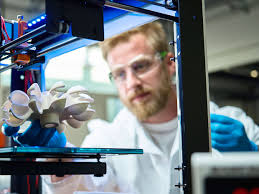Source: spectrum.ieee.org
3D printing is already being used to produce electric bikes, chocolate bars, and even human skin. Now, a new AI algorithm that learns each printer’s imprecisions can tweak print jobs to ensure greater accuracy.
The engineers who developed the algorithm find it increases a 3D printer’s accuracy by up to 50 percent. That can make a big difference for high-precision industrial jobs, says Qiang Huang, an associate professor of industrial and systems engineering at the University of Southern California, who helped create it.
Industrial 3D printers and additive manufacturing devices often use expensive materials, so the cost of throwing out prints that aren’t quite right can add up. For instance, it can cost hundreds of dollars in materials to 3D print a single airplane part. And some printers require seven to 10 drafts per job in order to fabricate an object that is accurate in every dimension and curve.
Huang’s group’s program, PrintFixer, requires a given printer to only produce five to 10 draft objects during initial setup. Once those objects are 3D laser scanned and compared to the computer-aided design (CAD) files that generated them, the algorithm develops a neural net model of the printer’s inaccuracies.
Then, when a new print job is sent to the same printer, PrintFixer recognizes the sorts of corners and curves that need to be distorted slightly so that the ultimate printed object is completely true to its design.
Huang says his group actually developed a new kind of machine learning algorithm to power PrintFixer. Existing image processing neural networks were mostly looking at the wrong thing for what his group needed to do.
“For additive manufacturing, you want to know what’s the accuracy, but for image processing you want to know its classification,” he said. “You want to know if it’s a cat or a dog in a different posture. The shape accuracy is not the main concern about the image.”
Instead, they approached the challenge as a sort of real-world integral calculus problem. Each layer a 3D printer lays down is like a narrow portion of the area underneath the curve of some mathematical function. (Say for instance, it’s the 34th successive layer required to print a sprocket.) From looking at the CAD file, they know what the shape of that 34th layer should be. And from the laser scan, they know what that 34th layer actually looks like.
So their algorithm performs a mathematical operation called convolution (not related to convolutional neural networks) that compares this small cross-section of the object with its idealized CAD file representation.
Add up all those convolutions over however many sample objects are scanned in, and the neural net begins to “learn” the quirks of the printer that created those objects. So when a new print job comes in, PrintFixer can compensate for the printer’s quirks and rendering peculiarities.
Huang says his group has already worked with Honeywell Aerospace and Hewlett Packard Enterprise to refine the algorithm. PrintFixer has not, however, been released to the public. “I’m hoping within three years we can make it available, if not sooner,” he says.
Among the complications still to be tackled are the different kinds of inaccuracies that crop up in 3D printing. Some simply pertain to the geometric shape of the object—one portion of the object should be a perfect circle, for instance, but it’s a oblong in one direction—and those are the sort PrintFixer is currently equipped to handle.
However, other inaccuracies come from processes like delamination, in which the layer beneath sticks to the new layer being laid down. And so the gooey sandwich of layers gets distorted in ways that PrintFixer’s neural net is not yet able to resolve.
In the meantime, Huang says he wants to make PrintFixer available to select users who can devote some of their own resources to the project. (His team is not big enough to provide customer support as would be required for a commercial software company.)
Aerospace and dental appliances are two industries that Huang suspects might be most interested in PrintFixer.
“When you 3D print those dental products, you want to learn what you’ve printed and make sure the next print will be very accurate,” Huang says. “So you can reduce the time, you can reduce the number of visits for the patient and also reduce the cost.”
Huang’s group describes its algorithm and the math behind it in a recent issue of the journal IEEE Transactions on Automation Science and Engineering.
Of course, now that they’ve developed this new machine learning algorithm, Huang says there may be other applications for PrintFixer’s novel neural net design beyond the realm of 3D printing. In fact, one or more of his PhD students are interested in this question.
“There are a few possibilities in my mind,” Huang says of new applications for PrintFixer’s machine learning algorithm. He wasn’t, however, able to offer specifics about those applications, because the work is still in a very preliminary stage. “That’s really what the research is for,” he says.
